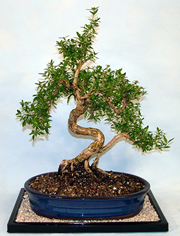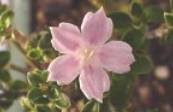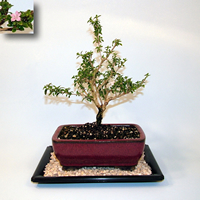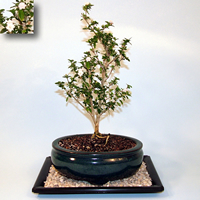Serissa are a nice addition to any collection due to their ability to bloom on and off throughtout the year. There are many different varieties including "Snow Rose" Serissa, Japanese White Serissa, Japanese Pink Serissa, Variegated Serissa, and Chinese Serissa, to name a few. Serissa are subtropical plants that grow well indoors. With a few simple guidelines your Serissa bonsai can be grown without difficulty.
Watering
Serissa, as with most bonsai, like to dry out between waterings. Feel the soil every day. If there is a rock in the planting lift it up and feel under it, otherwise, just stick your finger about a half of an inch to an inch into the soil. If the soil feels dry, water your bonsai. Never let your bonsai go totally dry for extended periods!!! The best way to water your bonsai is to soak it in a sink or container of water up to the trunk for about 5 to 10 minutes. Then allow it to drain. If top watering your bonsai, water, wait a few minutes, and water again. Repeat this several times to insure that your bonsai has received a thorough watering. Excess water will drain through the bottom drainage holes of the bonsai pot. Eventually you will be able to determine a watering schedule that meets your climate conditions.


Light
Serissa grow best in high light and thrive in sunny, warm locations. Better lighting conditions will result in more frequent flowering. Be careful of the intense afternoon sun shining through windows in the summer. It may sometimes burn tender tree foliage.
Feeding
Fertilize your Serissa bonsai once every two weeks during the growing season, spring until fall. We recommend using an organic liquid fertilizer such as a fish emulsion or an organic seaweed fertilizer. Chemical fertilizers may be used but should be diluted to approximately one half strength so that valuable roots are not damaged. Organic pellets such as rice cakes may also be used along with regular fertilizers.
Humidity
Humidity around your Serissa bonsai may be maintained by the use of a humidity tray or plate filled with stones and water. Your bonsai can be placed on top of the stones in the tray. The tray or plate will also offer protection from the water daining from your freshly watered bonsai. Misting once a day will also help…but remember, misting is not a replacement for watering.
Repotting
Serissa should be repotted about every two years. Serissa may be repotted throughout most of the year, although, the best times for repotting are in early spring. After repotting, water thoroughly and keep the plant in a shady location for several weeks so that new roots may grow.

Winter Care
Serissa bonsai should be kept indoors during the winter months. They should be maintained at winter temperatures above 55 degrees Fahrenheit.
Moss
Moss is certainly not essential to growing bonsai, but when moss is added to a bonsai it both enhances its beauty and improves moisture retention within the bonsai pot. If your bonsai has moss growing in it you can help to keep it alive by misting it regularly. If the moss dies, you may replace it with some of your own moss from your backyard.

Endnote
These instructions, when followed properly, will help keep your bonsai healthy and beautiful. There are many more publications available that offer more in depth information about your bonsai and we encourage you to read some of them. There are also local bonsai clubs and societies that offer many great learning experiences in the are of bonsai.
We hope you enjoy your bonsai experience as much as we have enjoyed ours.
Deprecated: strpos(): Passing null to parameter #1 ($haystack) of type string is deprecated in /home/agriviek8Qv/agriviet.net/public_html/wp-includes/comment-template.php on line 2522